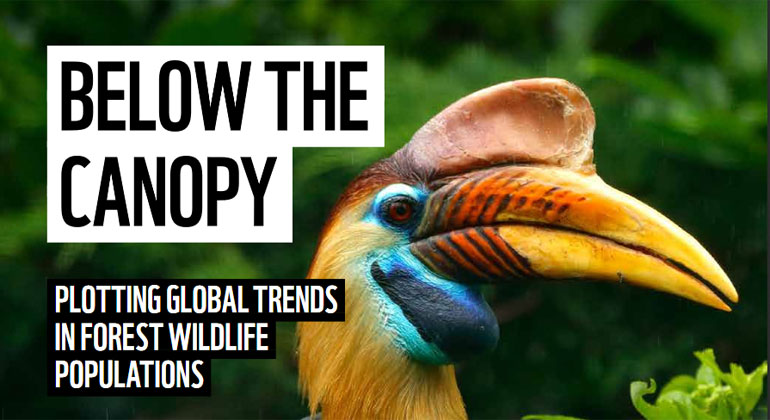Global forest wildlife populations in significant decline, new WWF report shows
The first-ever global assessment of forest biodiversity, Below the Canopy, shows that monitored forest-dwelling wildlife populations have shrunk on average by more than half (53%) since 1970.
The new report by WWF highlights the multitude of threats forest-living species are facing and shows that habitat loss and degradation, primarily caused by human activity, is the cause of 60% of the threats to forests and forest species. Declines were greatest in tropical forests, such as the Amazon rainforest.
The landmark report shows forests, which are home to well over half of the world’s land-based species and one of our most important carbon sinks, are vital to the health of the planet. Forest wildlife, in turn, provides vital functions to keep forests healthy and productive, such as pollinating and dispersing seeds and other crucial roles that affect natural regeneration and carbon storage. If we are to reverse the decline in biodiversity worldwide and avoid climate crisis, we need to safeguard forests and the species that live in them.
WWF is calling on world leaders to declare a planetary emergency and secure a New Deal for Nature and People by 2020 to stop climate breakdown, safeguard our planet’s remaining natural spaces, and make our consumption and production model more sustainable. Protecting and restoring forests must be at the heart of this agreement.
Will Baldwin-Cantello, Global Lead on forests at WWF, said:
“Forests are complex systems that depend on the wildlife that live in them to keep them healthy, and the rapid decrease in forest wildlife in recent decades is an urgent warning sign. Not only are forests a treasure trove of life on earth, they’re also our greatest natural ally in the fight against climate breakdown. We lose them at our peril. We need global leaders to immediately kickstart action to protect and restore nature and keep our forests standing.”
Remarkably, we know relatively little about real changes to the species that live in our forests at a global level. The Forest Specialist Index, developed by WWF following the Living Planet Index methodology (used within WWF’s flagship Living Planet Report), focuses on species that depend entirely on forests, which means this indicator provides an accurate representation of forest ecosystem health. UNEP-WCMC co-led the analysis and modelling for this report in collaboration with the Zoological Society of London (ZSL). The Forest Specialist Index shows that monitored populations of forest-living birds, mammals, amphibians and reptiles declined, on average, by 53% between 1970 and 2014, the most recent year for which data is available. Most of this loss is occurring in the tropics, where there is most wildlife to lose.
ZSL’s Louise McRae, Conservation Scientist and report author said:
“The first step towards protecting threatened wildlife is understanding trends in their populations and what drives their decline. By focusing our well-established Living Planet Index to create a new indicator for forest species, we can look below the canopy to see how wildlife within those forests are faring. Our analysis does just this, and reveals that many of the animal species that rely entirely on forests are dropping in number. Using this new indicator, we can continue to track forest wildlife and measure progress towards international agreements and biodiversity targets.”
The Forest Specialist Index also assessed whether forest cover alone – the most commonly used indicator globally – was an accurate indication of the health of wildlife below the canopy. The research found that while tackling deforestation and increasing forest cover are both essential to restore nature, these are steps alone are not sufficient.
“To reverse the decline in wildlife and the health of our forests, it is crucial to address the multiple pressures on forest species, including deforestation, illegal wildlife trade, unsustainable hunting, invasive species, climate change and disease,” Baldwin-Cantello said. “Future global frameworks and all future global forest assessments must include direct measures of both forest biodiversity and forest cover change. If we don’t address threats below the canopy we risk falling further into the ‘empty forests’ syndrome, where trees stand but much of the wildlife is lost.”
While the findings of the Forest Specialist Index paint a gloomy picture of the state of forest biodiversity, conservation success stories show us that forest-dwelling animals can recover with the right interventions. From monkeys in Costa Rica to gorillas in central and east Africa, the report highlights a number of solutions that have successfully helped populations of forest animals thrive again.
Protecting wildlife and reversing the decline of nature requires urgent global action. The report points to 2020 as a crucial year for securing international agreements for a New Deal for Nature and People, through a commitment by heads of state at the 75th United Nations General Assembly. World leaders are also expected to review the progress made on the UN Sustainable Development Goals, the Paris Agreement and, crucially, negotiate new 10-year targets for the UN Convention on Biological Diversity (CBD). Forests need to be front and centre of this New Deal for Nature and People because of their importance for biodiversity conservation, climate change mitigation and people, through the provision of ecosystem services, such as water and air purification, nutrient cycling, soil erosion control, and supplies of food, wood and other products.








